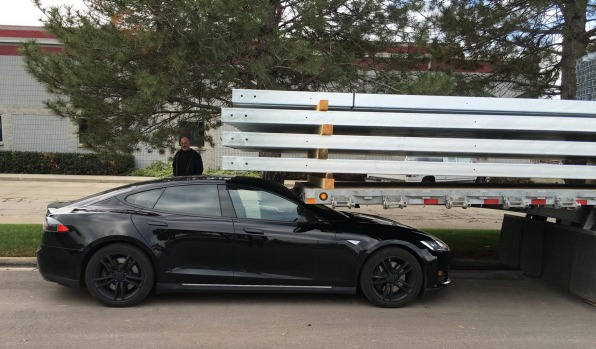Did a Tesla self-crash in self-park mode?
A recent news story from Utah describes a Tesla which entered self-park ("summon") mode and drive itself into the back of a flatbed truck raises some interesting issues.
Tesla says that the owner of the vehicle initiated auto-Summon, which requires pressing the gear selector stalk twice and then shifting into park, then leaving the vehicle. After that the car goes into its self-park mode in 3 seconds, and the driver is supposed to be watching because the feature is a beta.
The owner says he never activated the self-park, and if somehow he did by accident, he was standing by the car for 20 seconds showing it off to a stranger, and as such he claims he is absolutely certain the car did not begin moving 3 seconds after he got out. Tesla says the logs say otherwise.

Generally, one believes log files over human memory, though these stories are surprisingly at odds. When doing Summon, the Tesla is flashing its hazard lights and moving, so it's not exactly subtle. And it's not supposed to work unless the keyfob is close to the car. No doubt there will be back and forth on just what happened.
However, there are some things that are less disputed:
- Unless the owner is out and out lying, there is a problem which allowed an owner to activate the auto-summon feature by accident, and to do so when not close to the car. (When you activate it the hazards start blinking and it shows auto-park on the screen.)
- The car should not have hit the metal bars on the back of the flatbed. However, Tesla warns that the feature may not detect thin objects or hanging objects. These bars are quite low, but are sticking off the end of the truck by a large amount. Clearly the obstacle detection is indeed very "beta" if it could not see these. Apparently auto-park is done using the ultrasonic sensors, not the camera. Bumper based ultrasound is not enough.
This also adds some fuel to the ongoing debate about maps. The car was in a place where there would be no reason to initiate Tesla's self-park, which is designed for it to drive straight into narrow parking spaces. In this case, it is not necessary to have a map of all the spaces a car might self-park, but even a fairly coarse and inaccurate map could allow the car to say, "This seems like an odd place to use the self-park feature, are you sure?" And pretty much all parallel parking spaces on the side of the road qualify as a place you would not use this particular self-park function.
So is the owner lying? Was he playing with auto-summon and screwed up? (You have to screw up royally as it drives quite slowly and any touch on the door handles or the fob will stop it.) The problem is that he claims that the car did it while he was not present, which is not supposed to happen, and if he was present, why did he not stop it?








Comments
cjeam
Wed, 2016-05-18 09:14
Permalink
Load and detection
I'm not surprised the Tesla didn't see that load, it seems very unsafely loaded as anyone rear-ending that truck at speed would have been decapitated. Are under-run barriers that stop low vehicles running under the rear of trucks not compulsory in the US? or is this an exception because it's a load sticking beyond the flat-bed?
Miguel
Sun, 2018-10-28 08:57
Permalink
Add new comment | Brad Ideas
Great post.
My webpage: infiniti auto parts
Add new comment